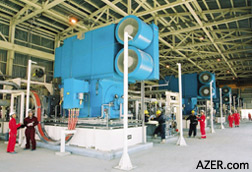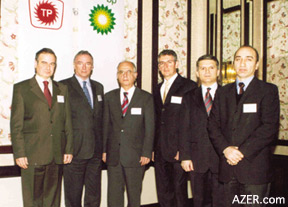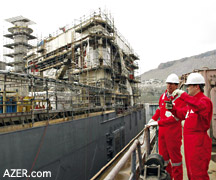|
Above: 1. Rob Kelly, Vice President for Shah Deniz and Mike Lutz, Commercial Manager for Shah Deniz discuss issues pertaining to the TPG 500 platform. 2. TPG 500 Platform Integrated Hull Loaded out from Caspian Shipyard Company. A total of 10 million barrels of crude oil is required to fill the 1770 km (approximately 1,050 miles) long line running from the Sangachal Terminal near Baku via Georgia to the Ceyhan Terminal on the Mediterranean coast of Turkey. The oil comes from the Azeri-Chirag-Gunashli (ACG) field in the Azerbaijan sector of the Caspian Sea. The staged filling of the pipeline along its entire route may take more than six months. The loading of the first tanker at Ceyhan is expected in the fourth quarter of 2005. The lengthy pipeline will enable one million barrels of oil a day to be exported safely and responsibly from the Caspian without increasing tanker traffic through the Turkish Straits. The pipeline is buried for its entire length and following construction land is being fully re-instated. In addition, the project's Community Investment Programme (CIP) is up and running in all three countries. Overall BTC, together with the South Caucasus Pipeline (SCP), being built to carry Shah Deniz gas from the Caspian to Georgia and Turkey, will spend some $30 million on community and environmental investment in Azerbaijan, Georgia and Shapoor during the construction phase. As we move into the operations phase, we are also developing a Regional Sustainable Development Programme (RSDP), which will build upon the best practice of existing CIP projects as well as addressing some of the regional and national challenges posed by the development of large-scale oil and gas businesses. West Azeri Platform Jacket Launched The jacket for the West Azeri (WA) production, drilling and quarters (PDQ) platform sailed away on May 7th, from the Heydar Aliyev Baku Deepwater Jackets Factory (BDJF) and was launched offshore onto the template at its permanent location in the Azeri field on May 8th. The WA PDQ jacket has been fully assembled in the country using local construction infrastructure including BDJF facilities. The total weight of the jacket is 14,400 tons. Its height is 133 meters. The jacket is being installed at a water depth of 120 meters. The jacket has 16 piles, with a total weight of 10,100 tons.  Right: The main BTC Pumpstation
at Sangachal Right: The main BTC Pumpstation
at Sangachal The transportation and installation of the jacket will use a number of SOCAR/KMNF vessels including the two principal installation vessels - the Derrick Barge Azerbaijan (DBA) and the STB-1 launch barge. The DBA has been further upgraded to undertake the installation work. The jacket transportation activities were also supported by two high capacity tugs - the Islay and the Jura. These are two identical vessels leased from the KMNF / BUE alliance fleet. The tugs were required to tow the STB-1 to the offshore site safely as the jacket's exposed windage area was very high. Other marine vessels involved in towage, anchor handling and supply boat trips were the Nercha, the Pacific Raider and the Svetlomor-2. The installation work has been carefully planned and it is expected to take 45-50 days to complete. This time frame makes allowances for the weather conditions. This milestone is yet another example of the production line success we have been achieving since the beginning of the construction activities. It brings us closer to the start-up of production from West Azeri early next year. TPG 500 Platform On April 6, the Shah Deniz gas and condensate development project successfully transferred the completed hull of the Shah Deniz TPG500 platform from the Floating Dry Dock (FDD) called Yusif Ibrahimov in the South Bay of Baku, to the topsides fabrication yard at Zykh for final installation of the platform legs and completion of the topsides facilities. Following the successful sea tow transfer of the TPG 500 integrated hull from the Floating Dry Dock operated by the Caspian Shipyard Company (CSC) to the Zykh yard, the hull is now moored at the Zykh 4 Quayside, where the Topsides integration works will commence soon. The final weight of the TPG 500 Hull is about of 13,500 ton at the time of delivery to the Zykh site.  In October 2004, four individual hull strips arrived in Baku and were safely floated onto the newly-refurbished dry dock. It took five months to join the four strips into a single floating unit to create the fully integrated hull. A multi-national labor force of more than 1,000 people worked very hard at the Dry Dock to achieve this important milestone. Safety has been a key issue with training in BP's Golden Rules, Specific Inductions for the Yard, Advanced Safety Auditing and Hazard Observations being conducted in each language of this multinational work force. We are proud that more than 1 million man hours have been expended without a single Day Away From Work Case. This was achieved by spending more than 17,500 man-hours on the training process by both the Caspian Shipyard Company (CSC) and BP. Work at the CSC yard in Baku will continue with the fabrication of the three permanent Foundation (Spud) cans with a total weight of 3,500 tons, and a Helideck support structure. These are due to be completed early in the 4th quarter of 2005. These fabrications will then be transferred to the Zykh site and assembled there. We expect that these activities will provide continuity of work and employment for many people at the CSC yard. Energy Bus A partnership which includes the Government of Azerbaijan, BP, the Organization for Security and Cooperation in Europe (OSCE), the International Finance Corporation (IFC), and the Eurasia Foundation is currently launching the Energy Bus - a project they have been developing for some time to help rural communities identify alternative energy solutions. The Energy Bus is a mobile exhibition on energy conservation and renewable energy generation. It is designed to provide broad knowledge about internationally practiced alternative energy resources and to help communities identify cost-effective and long-term energy solutions. The project will help raise awareness of existing means of easy access to low cost renewable energy generation such as simple solar panels, water heaters, wind power generators, mini hydro plants, sawdust heaters, biogas units to generate cooking gas, and advice on insulating houses. The project, which is funded by BP, OSCE, IFC and Eurasia Foundation, will be led by the Government of Azerbaijan as part of its drive to bring energy to the rural communities. It is planned that the Energy Bus with a mobile team of instructors, will visit some 100 -150 villages a year traveling through most regions of Azerbaijan. This year the project plans to send the Energy Bus to some 12 districts and towns including Ganja. The total cost of the project is about $450,000, of which one-third is financed by BP, and the remainder is provided by the other partners. The project is currently planned to last for two years and possibly be extended in the future. The project will be managed by the local non-governmental organization Umid. BP decided to get involved because it saw the Energy Bus as an opportunity to help people gain access to low-cost diversified energy resources. This will raise awareness of potential means of saving energy within communities and also support the Azerbaijan government in its poverty reduction efforts. The project will, where possible, use locally available low-cost materials and encourage local companies to create new manufacturing businesses to provide energy saving equipment. Bibi-Heybat School In March, the Azerbaijan International Operating Company (AIOC) successfully completed two community-designed micro-projects - a new gym and a First Aid station for the secondary school at Bibi-Heybat. These are part of the major Azeri-Chirag-Gunashli (ACG) Project Community Investment Programme (CIP) for the Bibi-Heybat area, where construction works for the Central Azeri Compression and Water Injection Platform (C&WP) are currently underway in the ATA (Amec, Tekfen and Azfen consortium) yard.  The project implementation started in April 2004 by the International Rescue Committee (IRC) with which AIOC signed a CIP Grant Agreement in March last year. The project value is $25,000 of which 75 percent was funded by the ACG Project and the remaining $5,000 was contributed by the Bibi-Heybat community members mainly in limestone bricks for construction and labor. Fazil Babayev, a sports teacher at the Bibi-Heybat school and one of the most active members of APC, says: "The old secondary school in Bibi-Heybat was built in 1936. Construction materials from a demolished mosque were used to build the school. Several generations of the Bibi-Heybat community have benefited from this education facility for many years. However, the school had no gymnasium. This fact has caused a decline in physical education activities. In cold months, schoolchildren had to take their physical education activity in open air and this resulted in frequent illnesses. Parents often complained about the situation. Everyone is happy to have this new facility." Health and Education Project - Garadagh In early April the AIOC launched the new Garadagh Community Assistance Programme (GCAP), a special assistance program to meet the most urgent health and education needs of the Garadagh District communities. The Program was launched on April 6 at the Lokbatan Hospital, where the GCAP will be based. The GCAP is part of the major Azeri-Chirag-Gunashli (ACG) Project Community Investment Programme (CIP) for the Garadagh District, where construction works for the expansion of the Sangachal Terminal are currently underway. The project, which will last 18 months, is designed to provide Garadagh residents improved access to health and education services over the next few months. The GCAP will be implemented by the International Medical Corps (IMC), a U.S. based, non-governmental organization with more than five years of experience developing the health and education systems in Azerbaijan. The scope of work to be conducted by the GCAP through the ACG's CIP funding, includes: rehabilitation and re-equipping of the Lokbatan Hospital Maternity Ward, provision of comprehensive medical services to the 1,300 Internally Displaced Persons (IDPs) temporarily living in the Umid settlement, training of doctors and nurses on modern medical techniques, and training of teachers to implement a healthy lifestyle curriculum in the schools of the Garadagh region. In addition, the GCAP is aimed at raising the Garadagh residents' awareness of their health and educational needs and building their capacity to address these needs through setting up peer health educator groups and community health festivals. All activities will be conducted in collaboration with community members, local Executive Committees, the Ministry of Health, the Ministry of Education, and two national non-governmental organizations (NGOs) - Sirius and EL, as well as with other NGOs implementing ACG projects in the Garadagh District. Back to Index AI 13.2 (Summer 2005) AI Home | Search | Magazine Choice | Topics | AI Store | Contact us Other Web sites created by Azerbaijan International AZgallery.org | AZERI.org | HAJIBEYOV.com |


